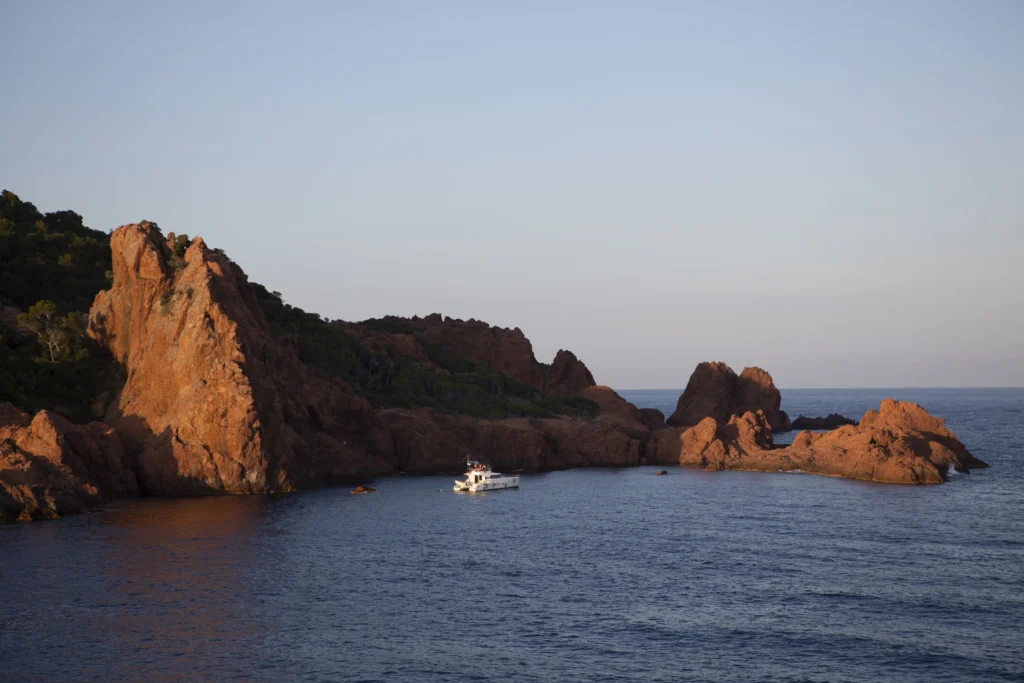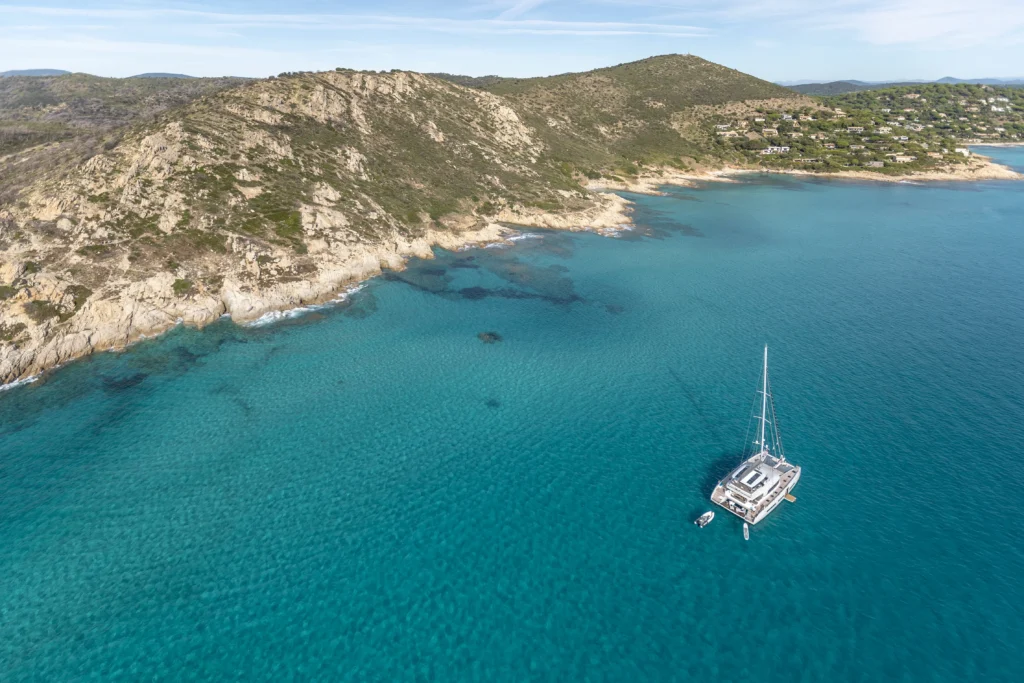Idyllic anchorages
We’ve all dreamed of the images proposed by shipyards in their brochures or displayed on trade show stands. Exceptional sailing areas and anchorages, sometimes on the other side of the world, but not always. Photographer Gilles Martin-Raget, who for many years has been producing images for major shipyards such as Beneteau, Jeanneau, Wally Yacht, Wauquiez and Fountaine Pajot, as well as for charter companies, shares with us some of his favorite spots in the Mediterranean. His recipe, inevitably a little restrictive: go off-season, from April to June and from September to mid-October, and don’t hesitate to get away from the busiest spots, as there’s bound to be an anchorage or good waters to sail right next door. And, best of all, there are many more to discover!
Sa Ràpita (Majorca)
It’s a fair-weather anchorage in the south of the island of Mallorca, the largest of the Balearic Islands, where the coastline is still in relatively good condition and free of disturbing buildings. An immense white sandy beach sheltered from north-westerly to north-easterly winds. It’s not exactly sheltered when the steady and sometimes solid Majorcan thermal breeze picks up during the day, but if your most secret fantasy is to one day sail into turquoise waters with all sails set, without having to ferry your boat to the Bahamas or Bora-Bora, this is a place not to be missed.
Sperone (Corsica)
The Bouches de Bonifacio are inevitably on the podium of every experienced sailor who has cruised the world. Whether on the Corsican side or towards the Maddalena archipelago in Sardinia, you can return again and again to the Bouches de Bonifacio and always find a new shelter, whether the wind is blowing from the east or west. One of the most spectacular is undoubtedly the one nestled in the shelter of the Pointe de Sperone, at the south-eastern tip of Corsica, a stone’s throw from the Lavezzi Islands. Surmounted by a golf course, whose green grass contrasts with the turquoise blue of the waters bordering the small cliffs of the cape, it’s a good shelter in a westerly wind. If the wind is easterly, you just have to change sides. What’s more, if you’re lucky enough to be a little out of season, you can drop anchor even closer to the spit of white sand that allows you to walk from Corsica to Piana Island. Don’t try to pass by boat, there’s really no bottom!

SAINT-FLORENT IN CORSICA CAN ONLY BE ENJOYED IN FINE WEATHER,
BUT THERE IS SPACE AT SEA AS WELL AS ON LAND ©Gilles Martin-Raget

BETWEEN FRANCE AND SPAIN IS BRIMMING WITH LITTLE NOOKS AND CRANNIES NOT EASILY ACCESSIBLE FROM LAND. ©Gilles Martin-Raget

SOME SPEND THE NIGHT MOORED ON ALL SIDES, BUT FOR A WALLY 80, IT’S JUST ENOUGH TIME FOR A PHOTO. ©Gilles Martin-Raget
Grebeni island (Croatia)
It’s not an anchorage and you’re not likely to drop anchor here, but if you happen to be in Dubrovnik, Croatia, and the weather is fine – really fine! -don’t hesitate to take the tiny passage that separates the islet Grebeni from its annex. It’s deep, narrow and necessarily negotiated under motor – your sails will be unsheathed – but the thrills are guaranteed.
Caprera (Maddalena archipelago)
This is another corner you won’t want your insurer to see, unless you’re a fan of extreme anchorages and your boat isn’t too big (although Luca Bassani, founder of the famous Wally yachts, did fit one of his 80-footers in here for a photo! ). Good weather is a must, and you’ll need a bit of preparation to get ashore to place all the bits that will hold you in the center of this very private bathtub. Essential condition: get there first!
L’Estagnol (Hyères harbor)
If the Provençal coast is your favorite playground, you’re bound to be reluctant to head for the crowded anchorages of Porquerolles or the all-too-few buoys in the tiny port of Port-Cros. If the wind is easterly or the weather is fine, you’ll prefer the northern edge of the Hyères roadstead between La Londe and Cap Bénat. The islets of Estagnol will be your landmark. There are fewer boats, the waters are just as azure, and the proximity of the Fort de Brégançon, the summer residence of the President of the Republic, prevents yachtsmen from doing just about anything.
Sormiou (Marseille creeks)
Generally speaking, regional and national parks have a twofold problem: while they protect nature, they also attract large numbers of people and are subject to increasingly stringent regulations for boaters. Created in 2012, the Parc national des Calanques, located just outside Marseille, is no exception to the rule, and even if the deep Calanque d’En-Vau continues to serve as the headliner on all the world’s brochures, you’ll hardly be able to drop anchor there. Prefer the wider calanque de Sormiou, which has the immense advantage of hosting a pleasant restaurant in the evening. The surrounding cliffs are a veritable Gruyère, allowing you to visit the Capelan cave with a flick of the flipper, which cuts right through the bec de Sormiou.

DE L’ESTÉREL, NEAR SAINT-RAPHAËL, IN THE HEART OF THE CÔTE D’AZUR ©Gilles Martin-Raget

WHERE TRANQUILLITY RETURNS IN THE EVENING WHEN THE “DAY ANCHORS” HAVE RETURNED TO THE HARBOURS. ©Gilles Martin-Raget

Cap Creus (Costa Brava)
The area has a bad reputation, and it’s true that when the tramontana blows in gusts off Roussillon, Cape Creus is as impossible to pass as its colleague the Horn at the tip of Tierra del Fuego. But when the weather’s fine, it’s also a landmark of crevices, offering a change of scenery as you cross the border between France and Spain. And if you want to save time on your way north, its colleague Cap Béar also has some pleasant anchorages to offer before you reach the picturesque village of Collioure.
Kornat Island (Croatia)
Once you’ve dropped anchor here, it’s hard to leave. It’s at the southern end of the Kornati archipelago in Croatia, on the island of the same name. It has all the characteristics of an anchorage in this magical archipelago: leafy vegetation, meandering coves with turquoise water at the far end, and three houses that make you wonder whose idea it was to build them in this inaccessible spot. It’s just a little less crowded during the tourist season than other anchorages in the archipelago. Paradise on earth exists, it can’t be invented, now you know where it is.
The Agriates (Corsica)
In north-west Corsica, between Île-Rousse and Saint-Florent, there’s a series of anchorages that are difficult to access from the landward side: this protects them from overcrowding by tourists, and they’re not very popular if the slightest mistral swell has formed further west. Malfalcu, Ghignu and Saleccia are the names of these coves, which are quite crowded during the tourist season by small boats from nearby ports. This succession of coves becomes a park scented with the scent of the maquis at the end of the day.
Cap Taillat (Côte d’Azur)
You know Saint-Tropez. The summer crowds, the indecently large superyachts, the traffic jams that lead to this inimitable cul-de-sac. But like all magnets, it concentrates its attraction at a very specific point, and particles outside its field of action have a field day. Not far from there, heading south, Cap Taillat offers those lucky enough to be able to visit it out of season or on weekdays until June or from September onwards, a pleasant surprise of natural surroundings, turquoise waters and sheltered anchorages on both sides of the peninsula.
L’île d’Or (Côte d’Azur)
You’ve heard of Tintin and l’île Noire, of course. But you may not know that this island exists near Saint-Raphaël, and that it’s quite red, at the tip of the spectacular red cliffs of the Estérel massif, just below the semaphore of Cap Dramont. A little island, a tower (inhabited by its owners from time to time, who hoist a flag when they’re present), offers us a small anchorage that’s a real change of scenery from the hustle and bustle of the Côte d’Azur or the Gulf of Saint-Tropez. A little crowded during the day, much less so in the evening.

